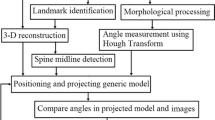Abstract
Scoliosis causes deformations such as twisting and lateral bending of the spine. To correct scoliotic deformation, the extents of 3D spinal deformation need to be measured. This paper studies the modeling and measurement of scoliotic spine based on 3D curve model. Through modeling the spine as a 3D Cosserat rod, the 3D structure of a scoliotic spine can be recovered by obtaining the minimum potential energy registration of the rod to the scoliotic spine in the x-ray image. Test results show that it is possible to obtain accurate 3D reconstruction using only the landmarks in a single view, provided that appropriate boundary conditions and elastic properties are included as constraints.
This research is supported by A*STAR SERC 0521010103 (NUS R-252-000-319-305).
Preview
Unable to display preview. Download preview PDF.
Similar content being viewed by others
References
Bernhardt, M., Bridwell, K.H.: Segmental analysis of the sagittal plane alignment of the normal thoracic and lumbar spines and thoracolumbar junction. In: 23rd Annual Meeting of the Scoliosis Research Society (1988)
Panjabi, M., White, A.A.: A mathematical approach for three-dimensional analysis of the mechanics of the spine. Journal of Biomechanics 4, 203–211 (1971)
Dumas, R., Aissaoui, R., Mitton, D., de Guise, J.: Personalized body segment parameters from biplanar low-dose radiography. IEEE Trans. Biomed. Eng. 52(10), 1756–1763 (2005)
Lam, G.C., Hill, D.L., Le, L.H., Raso, J.V., Lou, E.H.: Vertebral rotation measurement: A summary and comparison of common radiographic and CT methods. Scoliosis 3, 16–25 (2008)
Lin, H., Sucato, D.: Identification of Lenke spine deformity classification by simplified 3D spine model. In: Proc. Int. Conf. IEEE/EMBS, pp. 3144–3146 (2004)
Lin, H.: Identification of spinal deformity classification with total curvature analysis and artificial neural network. IEEE Trans. Biomed. Eng. 55(1), 376–382 (2008)
Verdonck, B., Nijlunsing, R., Gerritsen, F.A., Cheung, J., Wever, D.J., Veldhuizen, A., Devillers, S., Makram-Ebeid, S.: Computer assisted quantitative analysis of deformities of the human spine. In: Wells, W.M., Colchester, A.C.F., Delp, S.L. (eds.) MICCAI 1998. LNCS, vol. 1496, pp. 822–831. Springer, Heidelberg (1998)
Benameur, S., Mignotte, M., Parent, S., Labelle, H., Skalli, W., de Cuise, J.: 3D/2D registration and segmentation of scoliotic vertebrae using statistical models. Computerized Medical Imaging and Graphics 27, 321–337 (2003)
Benameur, S., Mignotte, M., Labelle, H., Guise, J.A.D.: A hierarchical statistical modeling approach for the unsupervised 3-D biplanar reconstruction of the scoliotic spine. IEEE Trans. Biomed. Eng. 52(12), 2041–2057 (2005)
Novosad, J., Cheriet, F., Petit, Y., Labelle, H.: Three-dimensional (3-D) reconstruction of the spine from a single x-ray image and prior vertebra models. IEEE Trans. Biomed. Eng. 51(9), 1628–1639 (2004)
Lenke, L.G.: Adolescent idiopathic scoliosis. The Journal of Bone and Joint Surgery 83, 1169–1181 (2001)
King, H.A., Moe, J.H., Bradford, D.S.: The selection of fusion levels in thoracic idiopathic scoliosis. The Journal of Bone and Joint Surgery 65, 1302–1313 (1983)
Kauffmann, C., de Guise, J.A.: Digital radiography segmentation of scoliotic vertebral body using deformable models. In: Proc. SPIE (1997)
Benameur, S., Mignotte, M., Parent, S., Labelle, H., Skalli, W., de Guise, J.A.: 3D biplanar reconstruction of scoliotic vertebrae using statistical models. In: Proc. CVPR, pp. 577–582 (2001)
Mitulescu, A., Semaan, I., Guise, J.A.D., Leborgne, P., Adamsbaum, C., Skalli, W.: Validation of the non-stereo corresponding points stereoradiographic 3d reconstruction technique. Med. Biol. Eng. Comput. 39, 152–158 (2001)
Antman, S.S.: Nonlinear Problems of Elasticity. Springer, Heidelberg (1995)
Press, W.H., Teukolsky, S.A., Vetterling, W.T., Flannery, B.P.: Numerical Recipes in C++: The Art of Scientific Computing. Cambridge University Press, Cambridge (2002)
Author information
Authors and Affiliations
Editor information
Editors and Affiliations
Rights and permissions
Copyright information
© 2009 Springer-Verlag Berlin Heidelberg
About this paper
Cite this paper
Li, H., Leow, W.K., Huang, CH., Howe, T.S. (2009). Modeling and Measurement of 3D Deformation of Scoliotic Spine Using 2D X-ray Images. In: Jiang, X., Petkov, N. (eds) Computer Analysis of Images and Patterns. CAIP 2009. Lecture Notes in Computer Science, vol 5702. Springer, Berlin, Heidelberg. https://doi.org/10.1007/978-3-642-03767-2_79
Download citation
DOI: https://doi.org/10.1007/978-3-642-03767-2_79
Publisher Name: Springer, Berlin, Heidelberg
Print ISBN: 978-3-642-03766-5
Online ISBN: 978-3-642-03767-2
eBook Packages: Computer ScienceComputer Science (R0)




